| 1 | Northern watersnake |
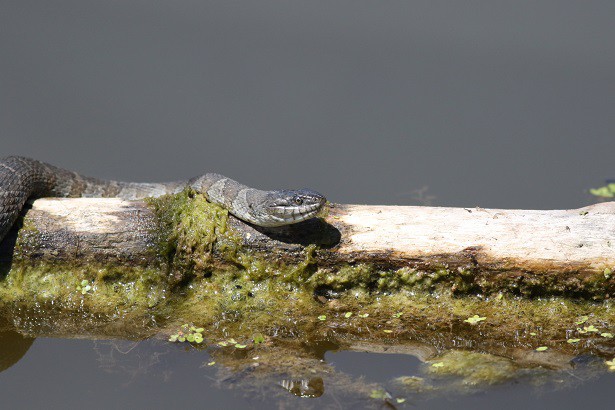
Northern watersnakes also featured in our “vicious non-venomous snakes” article, and that’s because they have a Dr Jekyll and My Hyde personality. This species averages at 70cm, maximum 135cm, and is particularly abundant in Ohio, Pennsylvania, Michigan and New York state.
Northern watersnakes appear in lakes and wide rivers, and won’t hesitate to bite savagely if manhandled. Their teeth are sharp like a serrated knife, but if spooked, they’d much rather flee at high speeds, sometimes not stopping until they reach the opposite shoreline.
A study compared them to their northern US river neighbours. While eastern ribbon snakes and common garter snakes generally stayed still, relying on their camouflage, northern watersnakes fled like a speedboat.
If they do escape, you won’t see them for a while, as northern watersnakes can hold their breath for 90 minutes underwater. Then they must surface for oxygen, but this can take just 2 seconds; it’s blink and you’ll miss it, even with binoculars. Scare one off, and your chance for a photo will be gone, but northern watersnakes are abundant, and one riverside zone can host plenty. Unless of course 10 other people are trying to get photos, and successfully scare every last one way.
| 2 | Red whipsnake |
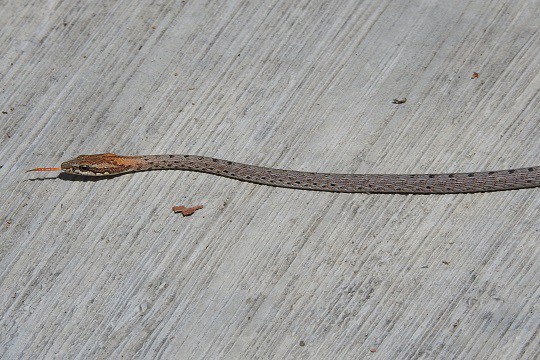
The red whipsnake is a Thai species found in forests and forest edges. They measure up to 1 metre, and aren’t red, more of a copper brown, with round pupils. This is a day-faring snake, and an active explorer, unlike the lazy green pitvipers nearby.
Because of their active personality, red whipsnakes regularly encounter humans. Bites are a possibility, as they have vicious teeth and a rapid lunge. But they much prefer to flee, forget about that area, and find a newer, safer one to explore and investigate. Red whipsnakes don’t care about battle pride. They’d rather just escape and get on with their day.
Red whipsnakes combine their lightning speed with high awareness of their surroundings. They’re extremely sensitive to birds, wind gusts, scientists, ghosts, you name it. Anything can trigger a sudden flight.
It would take a very patient reptile enthusiast to creep up on this snake. Maybe you’d get to within 5 metres after 2 minutes of tiptoeing, before excitement takes over and you start accelerating, feeling that you’re almost there. At the last second, the red whipsnake takes notice and blasts off, before you can even snap a photo.
| 3 | Northwestern garter snake |
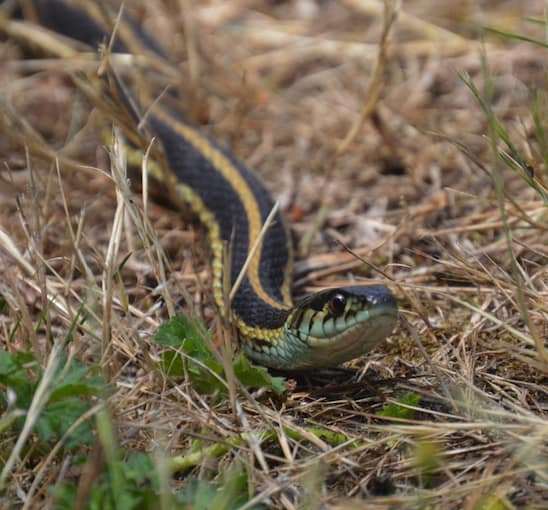
One of the US’s less famous garter snake species. This species inhabits northern California to southwest British Colombia. They can be separated from common garter snakes by vivid red spots on their bellies, and average at just 40cm.
Thamnophis ordinoides is one of the least aquatic garter snakes, preferring to live in woodlands and bushy fields, albeit always with water nearby. They can’t dive below water, they can’t unleash a corrosive venom (mainly because they haven’t got one), so northwestern garter snakes instead flee at top speeds. There’s a weird colour quirk with this species too. While striped forms flee straight ahead, in a no-nonsense style, spotted forms dart to the side, then freeze, relying on camouflage.
Thamnophis ordinoides flees so fast you may never notice they were there, particularly if you place a foot inches from them while admiring the scenic views ahead. The garter snake would speed away, or you might hear the rustle and assume it was a mere rabbit or mouse. Northwestern garter snakes are thin enough to become invisible in long, dry grass, unless you’re on your hands and knees.
| 4 | Striped whipsnake |
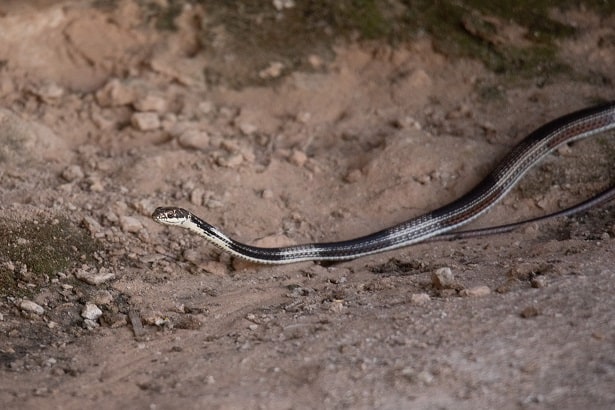
A widespread species of the US mid-west, part of the same Masticophis family as coachwhips. Striped whipsnakes can reach 180cm and are abundant in Nevada, Utah, Arizona, eastern California and New Mexico. Relative to their length, they’re exceptionally thin, and this grants them exceptional speed, unlike the bulky Great Basin rattlesnake they coexist with.
Striped whipsnakes are flexible, inhabiting woodlands and open dry fields, usually with vegetation nearby. They primarily eat lizards, which they grab and shove down without proper venom or constriction. When confronted with humans, they’ll hiss, mock strike, then suddenly flee at a million miles per hour.
Once they start, they’re off like a racehorse out of the gates. Striped whipsnakes can go from Omph to full flight in the blink of an eye. There’s no gradual acceleration. Nobody has fast enough reactions to catch Masticophis taeniatus; if you leapt out at them, you’d end up with a faceful of dirt. Sprint after them, and you’d just see a tail vanish into the undergrowth, before you bend over huffing and puffing. Striped whipsnakes have chosen escape as their survival niche, and this is where they excel.
| 5 | Spotted harlequin snake |
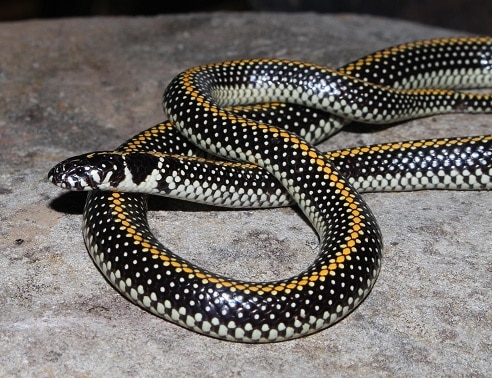
Spotted harlequin snakes are a wildly varying African species, commonly with neon spots like a thunderstorm in Las Vegas at midnight, or a bright red paintbrush stripe down their spine. When uncovered, their goal is to shock people into fleeing using these colours, but if this fails, it’s their turn to flee instead.
Spotted harlequins are short, at just 75cm. They avoid dense forests, but love woodlands, moist savannahs, and shrubby fynbo slopes. They have a mild venom, which is highly unlikely to kill. Spotted harlequin snakes lurk under cover objects like logs, rocks and wood choppings. If uncovered, they’ll attempt to dazzle you, then run for the hills if it’s apparent that their plan is a failure.
Homoroselaps lacteus also plans ahead, as they enhance their fleeing strategies by living in habitats with shrubby, bushy vegetation. This allows them to disappear into cover in a flash, rather than be visible in open fields. Spotted harlequin snakes ordinarily move slowly, but are fully capable of revving up. This snake belongs to the 2-member Homoroselaps genus, the second being the rarer striped harlequin snake.
| 6 | Greater green snake |
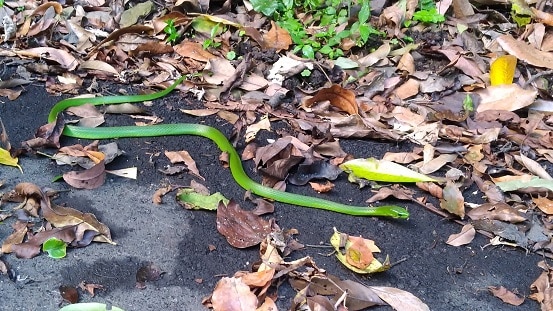
This 70-90cm species lives in southern China, northern Laos and Vietnam, and particularly Hong Kong. Green is virtually their only colour; they’re only stopped from being the greatest green snake by their dark eyes, unlike the Hagen’s pitviper of Thailand, whose are fully green.
Ptyas major feeds on earthworms, and are masters of sucking them out of soft soils. They’re found in grassy fields, parks, woods, anywhere that supports this slimy earthworm prey. They’re also experts at slithering fast, and climbing trees, but when faced with a human, their confidence fades. Greater green snakes aren’t equipped for attacking large animals, as their energies are focussed towards slimy soil creatures. They lack venom, or unusually vicious teeth.
When you approach Ptyas major, they will almost always lose their nerve and flee rapidly into the bushes. They have no stomach for a fight, and lack the killer instincts needed to attack. They rarely try intimidation tactics, like hissing, and lack viper-mimicking patterns. So Ptyas major has one option left – darting away and never being seen again. Fortunately, they do this well, with a whip-like speed which barely seems possible for a creature with no arms or legs.
| 7 | Painted marsh snake |
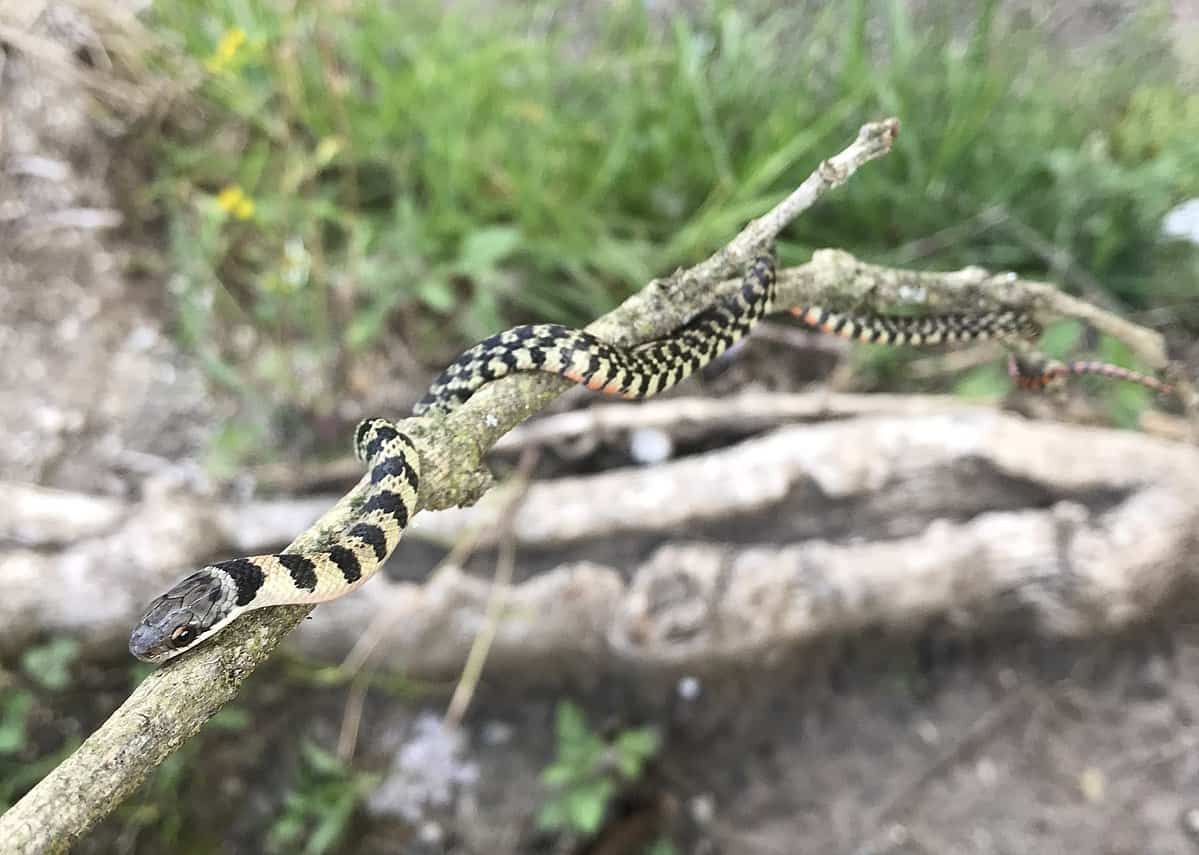
Ecuador is full of snake species that nobody has heard of, and the western slopes of the Andes are like an alien satellite that crash landed on Earth, spilling its creatures out into the surrounding forests. Tropical lightbulb lizards are one reptile endemic to Ecuador, and then there’s their predator: the painted marsh snake. This is a non-venomous species measuring 50-60cm, which is non-aggressive towards humans.
Painted marsh snakes move by day, and favour forests, but also appear in rural gardens. They’re only found above 1600 metres, and are missing from flatter coastal areas. To find one, you must drive deep into the Andes foothills, drawn on by the first towering peaks in the distance. Once you find one, you’ll have just seconds to make it official, as painted marsh snakes default to rapid flight when encountering humans. They flee into the undergrowth when spooked, rather than bothering to wait around and assess the predator.
This is a snake you’ll have to tiptoe towards to get a detailed view. Line by line, its patterns will come into focus, as the painted marsh snake stares ahead, eagerly watching a toad which it hopes hasn’t spotted it, just as you hope the snake hasn’t noticed you, like a circle of stealth. Behind you, the circle could continue as a policeman watches you, wondering why an unshaven westerner is tiptoing around the forest with a camera. Painted marsh snakes are fairly common in northern Ecuador, where one of their neighbours is the Ecuador ringed tree boa.
| 8 | Brown forest cobra |
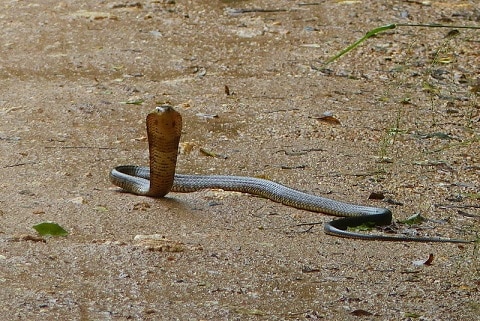
Few people could bump into a wild cobra without feeling a spike of fear, but brown forest cobras are one of the more dodgeable of the family. Its venom contains potent neurotoxins and cytotoxins, which disable brain signals and assault skin tissue respectively. But brown forest cobras are a shy species. They’ll rear up, hiss and form a hood (fairly narrow), but flee rather than fight when push comes to shove, unless cornered against a brick wall.
That’s not likely to happen, as Naja subfulva strays to human habitation significantly less than the cape cobra. They inhabit forests and savannah woodlands, clinging to bushy vegetation rather than open grassland.
Brown forest cobras are the longest cobra in southern Africa, reaching 2.69 metres. They were originally part of the forest cobra (Naja melanoleuca) species, but separated along with 3 other subspecies to become a 5 member forest cobra complex. Brown forest cobras mainly inhabit Mozambique, Tanzania and Uganda, and are mainly brown, while darkening lower down until an almost black tail. While less aggressive than some, Naja subfulva is still a cobra, and you should always be cautious.
| 9 | Green watersnake |
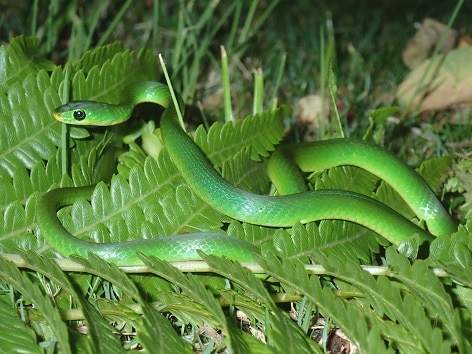
A snake of Tanzania, Mozambique and eastern South Africa, which has never killed and rarely even attacks. The green watersnake measures 50-60cm, and inhabits mainly moist areas of south Africa, including lakes and ponds, sticking to the well vegetated edges. They’re a semi-aquatic snake, but skilfully weave up tree trunks as well.
Philothamnus hoplogaster often inhabits edges of ponds in trails popular with humans, and if you meet one, they’ll probably stay still at first, trying to blend with grass. Then it gets unpredictable. You could back off slowly, in a slight panic, but holding your nerve. The snake, which is also panicking, will then slither slowly on its way. But only a slight movement could cause Philothamnus hoplogaster to blast into the water and never be seen again.
Actually, if you live nearby, you might be seeing the same few green watersnakes for years on end. Individuals are impossible to distinguish at a glance, so while it may feel like “just another green snake”, it might actually be the old acquaintance that fled 5 years ago. Green watersnakes mainly prey on frogs, and are sometimes confused with green mambas.
| 10 | Korean ratsnake |
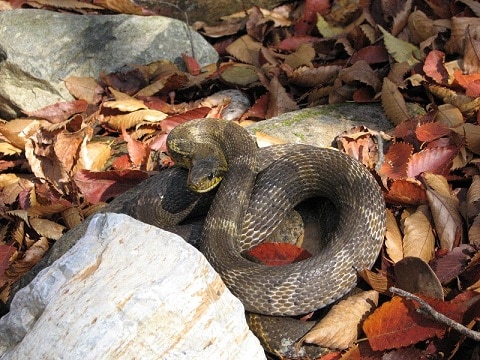
A non-venomous snake of the Korean peninsular and southern China. This species measures 150-180cm, and eats a diet heavy in rodents. Korean ratsnakes (Elaphe anomola) would have a painful bite if they possessed the concentration to wield it, but instead, all their instincts are geared towards fleeing. This keeper found that when he entered the room, his Korean ratsnakes instantly hid below cork-bark within their terrarium. In the wild, they’ll abandon ship and head to the safety of a forest, or a heavily vegetated riverside.
Elaphe anomola has a high perception of danger, and prefers to flee to guarantee its safety. It might then hide in a hollow log or burrow, before trying again the next day. This was once a subspecies of the Russian ratsnake (Elaphe shrenkii), before being elevated to a full species.
Non-venomous snakes don’t always flee as a rule. For example, the white-bellied ratsnake freezes when approached, attempting to blend in. UK grass snakes attempt to hide their heads. But frantic flight is another option available to non-venomous snakes. Those who choose it become gradually more proficient over time; hence why Korean ratsnakes can disappear in what feels like milliseconds. 5 million years ago, they may have been slightly slower than now, before the weakest ones were picked off, leaving the fastest individuals to drive the ratsnake family ahead.
